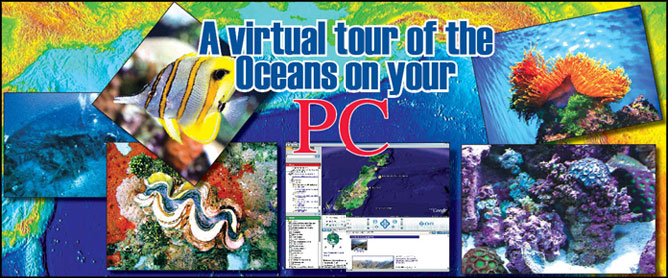|

There are many who say that the
name of our planet should be Ocean, not Earth. They have a point. After
all, the planet is 72 per cent water. It is a Blue Planet, as the
popular BBC TV series highlighted.
But not everyone can explore the depths of the Ocean a la Cousteau.
Most of us will never be able to dive the oceans. Apart from watching TV
programs on underwater life, the best hope for most is a peek at the
ocean floor through a glass bottom boat.
This is where Google comes in with Google Ocean, an extension to its
wildly popular (500 million downloads since June 2005) Google Earth
program. Google Ocean gives us a chance to explore the Ocean without
ever getting our feet wet. Even a landlocked Mongolian can now become an
expert on the Oceans with Google Ocean.
Ocean, which launched February 2, builds on the popular 3-D mapping
tool Google Earth by allowing users to navigate underwater in
unprecedented clarity. The latest version, Google Earth 5.0, has Ocean
built-in.
New satellite-based software include topographic maps of the
seafloor, locations of shipwrecks and algal blooms, and even maps of
tiny phytoplankton that provide the bulk of the ocean’s food chain.
Within the more than 20 layers of information, users can explore
multimedia features that combine data and maps with quizzes, and other
interactives.
Google has collaborated with many organisations including National
Geographic to develop the software and content. There are plenty of fact
sheets and videos to simulate interest.
The new fish-eye view-accessible via a free upgrade-aims to provide a
public platform for users to talk about the oceans, says John Hanke,
director of Geo Products at Google.
The idea first came to well-known marine biologist Sylvia Earle at a
conference in Madrid, Spain, a few years ago, when she addressed Hanke
during a presentation.
The feature known as Shipwrecks is very interesting. Users can
venture beneath the waves to find the final resting places of famous
lost ships and explore more than 40 wrecks via videos provided by a
Canadian company.
Titanic may be top of the list for most people, but there are
hundreds of other interesting shipwrecks.
You can also track whales, sea turtles and other identified species
through Google Ocean. You can also find favourite surf and dive spots.
In addition to the wonders of the deep, Google Earth users will also now
be able to view the evolution of certain locations through history.
Using the “historical imagery” option, it is possible to view the
development of cities, such as London and Las Vegas, over time through
the use of archival satellite footage.
There are also updates on the terrestrial side, including GPS
tracking, virtual time travel (where users can observe changes in
satellite images) and narrated tours of imagery and content. There are
also updates to the Mars 3D section.
Al Gore, who was at the launch event in San Francisco said that the
update would make Google Earth a “magical experience.
You can not only zoom into whatever part of our planet’s surface you
wish to examine in closer detail, you can now dive into the world’s
ocean that covers almost three-quarters of the planet and discover new
wonders that had not been accessible in previous versions.”
- Pramod
|


